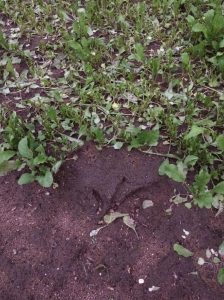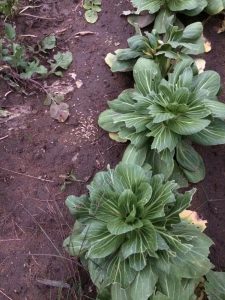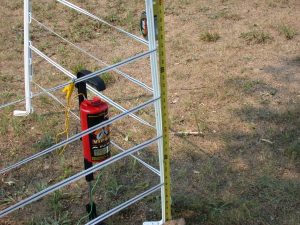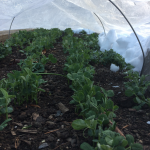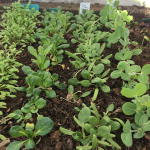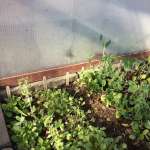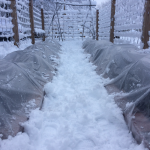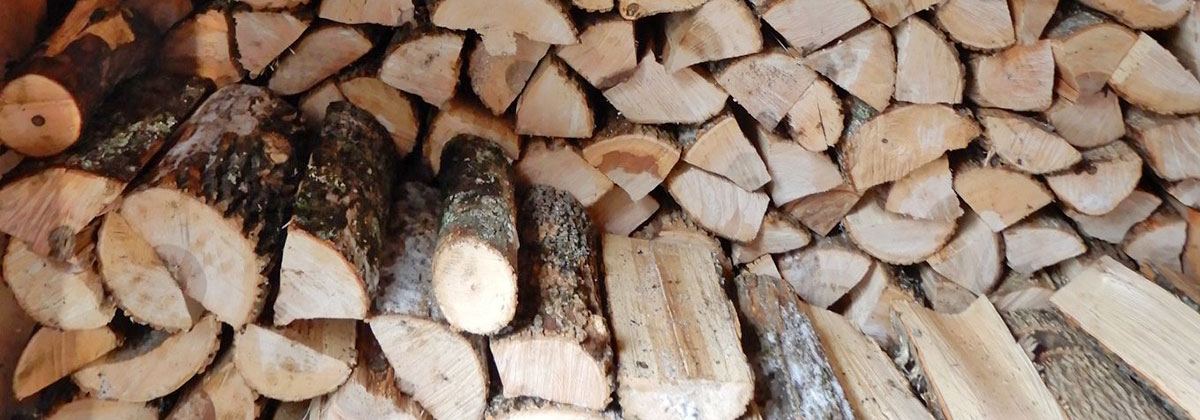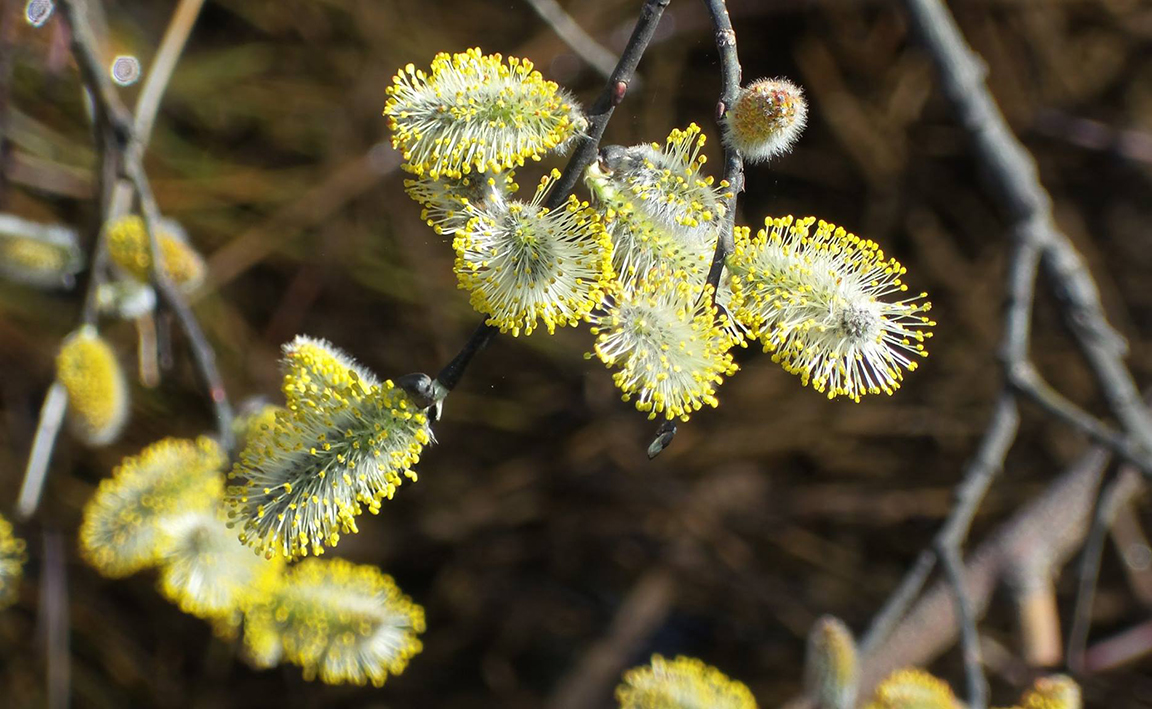
Maine Home Garden News — March 2021
In This Issue:
- March Is the Month to . . .
- Calendar of Apple Orchard Management Activities
- Protecting Home Gardens from Mammals: Fencing
- Season Extension in Action
- Backyard Bird of the Month
- Proposed State Rules to Slow the Spread of Emerald Ash Borer
- Upcoming Learning Opportunities
March Is the Month to . . .
By Kate Garland, Horticulturist, UMaine Extension Penobscot County
- Pay it forward by purchasing a Community Supported Agriculture (CSA) share. Farmers offer a wide range of mutually beneficial partnerships with their customers to help keep farms sustainable through the slower winter months and to keep customers filled with delicious fresh produce throughout the season. Click here and scroll down for more information on debit-style and farmer-select CSA programs.
- Prune select woody plants. March is a great time to put those freshly sharpened pruners to work, because it’s easy to see where branches are crossing, damaged or dead. For more information, view the video Pruning Ornamental Trees below and check out UMaine Cooperative Extension Bulletin #2169, Pruning Woody Landscape Plants.
- Make a twiggy trellis. These homemade garden features are both beautiful and long-lasting. Look back on this pictorial article from a previous Maine Home Garden News issue, showing step-by-step instructions.
- Get a jump start on spring by forcing branches indoors. Forsythia and crabapple are common favorites for this spring tradition, but you can savor glimpses of warmer days ahead by placing any fresh woody branch cuttings in water indoors. Not all branches will produce flowers, but they should all eventually leaf out. Try a few different options; you might be surprised by what you see!
- Check out the calendar of apple orchard management activities and plan ahead for managing insects and disease.
- Consider adding ferns to your landscape this spring. As the snow melts, I always appreciate seeing the steadfast vibrant green of marginal wood fern and Christmas fern soaking up all the spring sunshine, before the deciduous canopy begins to cast shade. Ferns are hardy, diverse, and well-suited for some of the more challenging conditions in our landscape. Learn more at Ferns.
- Visit your local maple syrup producer for a sweet taste of Maine. Maine Maple Sunday Weekend is set for March 27 and 28, but many producers are welcoming visitors over several weekends to minimize crowds. Be sure to check out their website and social media before visiting to find out about protocols and hours.
- Here are some seeds you’ll want to start indoors*:
- Early March: onions, leeks, shallots, spinach, parsley, foxglove, verbena, delphinium, dianthus
- Mid March: cabbage, celery, kale, kohlrabi, blanket flower, hollyhock, hibiscus, petunia, salvia, snapdragon, stock
- Late March: lettuce, artichoke, broccoli, cauliflower, eggplant, Swiss chard, ammi, calendula, cardoon, globeflower, bee balm, statice, strawflower, sweet pea
*In coastal Maine, plant 10-14 days earlier. In northern Maine, plant 10-14 days later.
Calendar of Apple Orchard Management Activities
| Time | Activity | Purpose | Frequency |
|---|---|---|---|
| February to Bloom | Complete dormant pruning. | Keep fruit-to-shoot growth balanced; remove dead wood and improve light penetration. | Every year. |
| Before buds open (Green Tip) | Rake leaves. Burn, bury, or mow to shred and speed leaf decay. | If not done previous fall, do now to reduce spring population of apple scab spores. | |
| Bud swell to Green Tip | Apply dormant oil. | Control spider mites and scale insects. | Once a year if scales and mites are a problem. |
| Green Tip to Petal Fall | Apply fungicide. | 1st generation apple scab control. | Before any rain that causes leaves to stay wet more than 6 hours.
One application protects for 7 days or 2 inches rain, whichever is first. |
| During Bloom | Identify and mark wild apple trees, to remove at any time.
Check trunks for borer attacks that started last year. |
Reduce disease and insect pest pressure.
If possible, dig them out to prevent structural damage to trunk. |
As needed.
Check for borers in both May and September, but once a year is better than never. |
| After Petal Fall | Apply insecticide. Spray Sevin (carbaryl), 2-3 sprays at 10-day intervals starting at Petal Fall.
Remove fire blight infections. |
Control plum curculio weevils, reduce codling moth and a variety of foliar- and fruit-feeding caterpillars. Carbaryl also thins apple crop which improves fruit size and reduces biennial bearing.
Prevent further spread and loss of branches or whole trees. |
2-3 applications.
As needed. Most fire blight strikes appear within one month after bloom. |
| Petal Fall to four weeks before harvest | Apply fungicide at 2-4 week intervals. | Secondary apple scab control as needed; also prevents sooty blotch and flyspeck diseases and fruit rots. | Before rain. Each application protects 14-21 days or 2 inches rain, whichever is first.
Interval between fungicide sprays depends on frequency and amount of rain, and disease pressure based on observations and/or disease history. |
| July and August | Hang sticky red ball traps on branches near canopy edge, visible from outside of tree, to catch apple maggot flies (AMF). Renew stickiness every 3 weeks.
Insecticide. |
Apply first insecticide spray when average of 1 AMF are caught per trap. Start counting again 10 days after application. Respray if/when 1 more AMF are caught per trap. Traps provide control when used at rate of 1 trap per bushel; this requires multiple traps per tree.
If not using red sticky traps, control AMF in mid-to-late July, early and mid-August. |
Check traps at least twice weekly for timing.
Each insecticide application protects against AMF egg-laying for about 10 days or 1 inch of rain. Summer insecticide also reduces chance of attack by trunk boring insects. |
| September to November | Harvest fruit; clean up fallen fruit.
Check trunks for borer attack sites. |
Munch, crunch, a bunch for lunch! Fallen fruit is slippery, and provides food for voles.
If possible, dig them out to prevent structural damage to trunk. |
Some cultivars ripen all at once; others are best harvested over a period of time for best quality.
May and September checks are useful, but once a year is better than never. |
| November to December | Rake leaves. Burn, bury, or mow to shred and speed decay.
Place trunk guards around tree trunks to remain until spring. Whitewash trunks. |
Reduce overwintering apple scab spores.
Protect from vole feeding. Reflective coating reduces risk of trunk damage by rapid thaw-freeze cycles. Coating may deter insect borers, and makes borer attack sites easier to find. |
Rake once after all leaves have fallen.
As needed to prevent voles from girdling trunks. Keeping grass mowed in summer and fall also helps reduce voles. Whitewash should last a year. |
From the GardenPro Answer Book; revised and updated by Lois Berg Stack, Ornamental Horticulture Specialist, University of Maine Cooperative Extension.
Apple management information courtesy of Glen Koehler, Associate Scientist, Apple IPM, UMaine Cooperative Extension.
Protecting Home Gardens from Mammals: Fencing
By Adam Vashon, Wildlife Biologist USDA APHIS Wildlife Services with helpful reviews by
Donna Coffin, UMaine Extension Professor, Piscataquis and Penobscot Counties
This is the first article in a series of three. Stay tuned in future months for tips on controlling common urban species (dogs, cats, and woodchucks) and woodland species (deer, raccoon, and turkeys).
Each passing day gets us closer to the time when we will be tilling soil, planting seeds, weeding gardens, and harvesting our produce. Even the smallest garden demands time, effort, and dedication. And with all that effort, there is nothing more frustrating than seeing crops devastated by pests. Many gardens are damaged or destroyed each year by common mammals when simple steps could have prevented the damage.
Common garden pest mammals range in size from voles to black bears and everything in between. The methods to control them are often relative to their size and behavior. In a perfect world, wildlife professionals solve conflicts on a species-specific basis. However, gardeners aren’t always sure what is causing the damage. Fencing can exclude the majority of species from your garden, providing long-term protection.
-
Wild turkey track in a vegetable crop. Photo courtesy of USDA Wildlife Services – ME.
-
Wildlife damage to vegetable crops. Photo courtesy of USDA Wildlife Services – ME.
Conventional Fencing. Simple fences are a familiar way to protect your harvest. Galvanized steel is probably the most popular type, being both efficacious and cost-effective. Welded wire and hardware cloth, two common forms of steel fencing, combine relatively low cost with moderate durability. They are readily available in rolls of various lengths, widths, and mesh size. Hardware cloth mesh size ranges from ¼” to 1½”, while welded wire offers larger mesh size up to 4” or more. These fences are also offered in vinyl coatings that can make them more attractive and durable.
A perimeter fence constructed of welded wire, 4-6 feet tall, and with 2×4” openings, will exclude most medium-sized, garden-raiding animals such as raccoons or neighborhood cats or dogs. Using a finer mesh size at a lower height (18-24”) would prevent access by smaller mammals like rabbits and voles.
Most importantly, keep in mind that many animals can climb, jump or burrow. The best exclusion fences extend a foot or more below ground level to defeat burrowing mammals like woodchucks, chipmunks, and voles. If deer are the offenders, the fence must be at least 8 feet tall.
Electric Fencing. When installed properly, the effectiveness of an electric fence cannot be overstated; however, certain technical aspects of electric fences are often overlooked.
Simply put, and with only a few exceptions, if an electric fence fails to exclude wildlife, something was not working as it should. Grounding problems are one of the most common issues, resulting in low voltage fences that deliver insufficient shock. Here’s a site with 20 common mistakes to avoid when building an electric fence. Gardeners should take the time to educate themselves on how electric fences work so that they can be used successfully.
-
An electric fence designed to exclude deer that uses poly-rope material and is baited with peanut butter. Photo courtesy of USDA Wildlife Services – NH.
-
An example of a multi-strand electric fence that uses poly-tape material to exclude wildlife. Photo courtesy of USDA Wildlife Services – NH.
In home garden settings, electric fences may cost more than wire fences. However, they typically work better and will provide many years of effective exclusion.
Tunnel Fencing. For smaller stature crops such as greens, carrots, and cucumbers, a series of hoops covered with a physical barrier such as row cover, netting or welded wire can be a low-cost, low-commitment option for deterring some types of wildlife. Keep in mind that row covers will restrict pollinator access to certain crops, such as cucumbers and squash, that need pollination to develop fruit. While tunnel fencing is not as reliable and effective as the previous two fencing options, this might be more doable for small-scale backyard and community garden growers.
For more information on protecting your gardens from wildlife damage, please contact USDA Wildlife Services at 207.629.5181, or 1-866-4USDA-WS.
Season Extension in Action
Photos and captions by Christina Lannan, Penobscot County Master Gardener Volunteer.
Intro by Kate Garland, Horticulturist, UMaine Extension Penobscot County
There’s so much to say about season extension that it can be hard to know where to begin. When you’re just getting started, it can be overwhelming to digest all of the information that’s out there. Sometimes it’s good to just step back and observe season extension in action. I coaxed one of our humble local Master Gardener Volunteers, Christina Lannan, to share a few snapshots of the incredibly productive little space she keeps going nearly year-round in her suburban front yard in central Maine. It’s sure to inspire!
Click on the images below to view enlargements.
-
11/03: October-sown peas for shoots. Heavy snow the night before collapsed one side of the plastic but the peas were fine. I find venting is the biggest issue with autumn extension. Cool rainy days can cause mold issues if the moisture is trapped under plastic without a way to circulate, so don’t seal things up too tightly.
-
2/14: Seeds direct-sown in fall will take off in mid-February after the daylight increases above 10 hours. This is when I start watering if needed. Planted left to right: claytonia, tatsoi, spinach, peas. Not shown, but one of my favorites for fall sowing is cilantro.
-
3/19: Sprouting broccoli, kale, pak choi, spinach seedlings started on 2/23 under spun row cover and greenhouse plastic. The plastic was placed over the beds two weeks before seeding to raise soil temps. Row cover was simply draped over newly seeded flats.
-
3/27: Store-bought cold frame against a south facing wall. Small digital thermometers are a great way to keep track of temperatures and humidity. Temperatures shown in Celsius.
-
4/10: Heavy, wet spring snows can crush small seedlings. In these raised beds, I use 9 gauge wire to create low tunnels covered with 4 mil greenhouse plastic. Bricks secure the plastic along the edge.
More information:
- Extending the Gardening Season, University of Maine
- Extending the growing season: start early, end later, University of Minnesota
Christina Lannan is a Penobscot County Master Gardener Volunteer deeply committed to school gardening and food security efforts in the Old Town region.
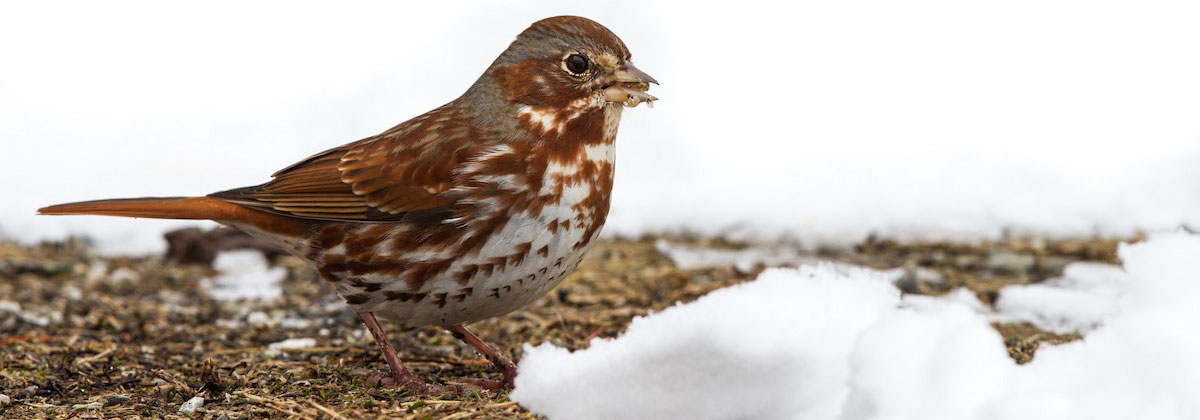
Backyard Bird of the Month
By Doug Hitchcox, Maine Audubon Staff Naturalist
Fox Sparrow
March can be a dreary time for bird watching as we find ourselves in a diversity lull. Winter finches have departed and the northward waves of neotropic migrants are just hitting the Gulf of Mexico on their way back from wintering in Central and South America. Fortunately, there are a few gems to be seen. The Fox Sparrow is likely to be spotted scratching the bare patches of your garden, hoping to uncover tasty seeds. This oversized sparrow has big blotches of red on the face and breast, extending across the back and all flight feathers. Historically a breeder in the Canadian boreal forest, it is one of the only species that appears to be expanding its range southward, while most boreal breeders are retreating north with climate change. With the breeding grounds as close as northern Maine, Fox Sparrows can be heard testing out their territorial songs on warm March days across the state, before they return to their spruce-fir nurseries.
For more on the importance of Maine native plants to support birds and other wildlife, visit Maine Audubon’s “Bringing Nature Home” webpage.
Proposed State Rules to Slow the Spread of Emerald Ash Borer
Public comments are sought regarding proposed rules to continue regulating the movement of ash wood materials and to expand the regulated areas
Ash (Fraxinus) is an important street tree and a valuable timber species, accounting for around four percent of Maine’s hardwood forest inventory. Ash wood is known for its strength and elasticity, making it a popular choice for baseball bats, axe handles, and guitar bodies. The brown ash is central to the cultural traditions of the Wabanaki people and is essential for their basketmaking.
Unfortunately, all ash species other than mountain-ash are currently threatened by the Emerald Ash Borer (EAB). This invasive beetle, first observed in North America in 2002, is now found in 35 states and several Canadian provinces. EAB larvae have killed hundreds of millions of ash trees in North America by feeding on the trees’ inner bark, cutting off the flow of moisture and nutrients.
When ash wood infested with Emerald Ash Borer is moved, it can spread this insect to new areas, causing significant ecological and economic damage. There are no practical means to control EAB in forested areas, though pesticides can protect individual trees.
For some time, federal quarantine regulations have restricted the movement of ash wood materials (such as firewood, lumber, chips, and nursery stock) from locations where infestations have been observed. In Maine, these regulations applied to areas containing about 10% of Maine’s ash trees, primarily in York, Cumberland, and Aroostook Counties.
Recently, the USDA concluded that non-regulatory measures such as voluntary introduction of biological controls would be more effective than quarantines in controlling EAB. A decision was announced on January 14, 2021, to end the federal regulations.
However, scientists with the Maine Forest Service and the Plant Health Program of the Maine Department of Agriculture, Conservation and Forestry continue to see quarantines as an effective measure to slow the spread of EAB in Maine. They have proposed new state rules to continue regulating the movement of ash wood material from infested areas and to expand the regulated area in Aroostook County.
If these changes could affect you, please review Maine’s proposed EAB quarantine rules and consider making public comment.
There are two ways to comment:
- You can join the meeting using MS-Teams or by telephone at 207.209.4724, confirmation code: 390 166 010#.
- Written comments may be submitted until 5 PM April 2, 2021, to gary.fish@maine.gov or Gary Fish, Maine DACF – Horticulture, 28 State House Station, Augusta, ME 04333-0028.
More information on EAB can be found on the Maine Department of Agriculture, Conservation and Forestry’s EAB website. Questions about the proposed rules can be directed to gary.fish@maine.gov or by telephone at 207.287.7545.
Upcoming Learning Opportunities
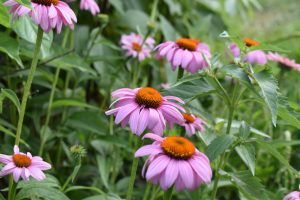 Gardening Webinar Series
Gardening Webinar Series
Join the University of Maine Cooperative Extension and the University of New Hampshire Cooperative Extension for the final two sessions of our winter webinar series! The 1-hour webinars will include a 40-minute presentation, followed by Q&A and discussion.
Registration is required with a $5 suggested donation (optional) for each webinar. Participants will receive the Zoom information after registering for a webinar. All sessions will be recorded and shared with participants following the event. If you can’t attend the live session, please register to receive a copy of the recording and a resource list.
Ornamental Garden Design, Wednesday, March 10, 6:00 – 7:00 PM
Instructor: Charlene Gray, Program Coordinator for Environmental Horticulture and Sustainable Agriculture for the University of Maine
Registration: Online (registration closes at 4:00 PM on March 10)
Protecting Fruit Trees from Insects and Diseases, Wednesday, March 24, 6:00 – 7:00 PM
Panel: Glen Koehler, Associate Scientist of Integrated Pest Management for the University of Maine and George Hamilton, Fruit & Vegetable Production Field Specialist for UNH Extension
Registration: Online (registration closes at 4:00 PM on March 24)
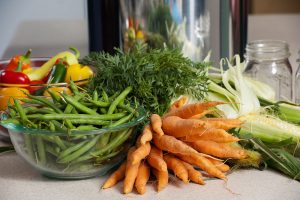 “Cooking with the Maine Harvest” March Webinars
“Cooking with the Maine Harvest” March Webinars
UMaine Extension Food and Nutrition staff are offering two webinars in March to help you prepare for the food preservation season. We are halfway through winter, so it’s time to begin using up your precious cache of frozen berries or canned vegetables. On March 9, we’ll share tips for using home-frozen fruit in cooking and baking. On March 23, discover creative uses for home-canned goods.
- March 9 — Using Frozen Fruit in Baking and Preserving
- March 23 — Using Home Canned Foods in Cooking
Registration is required; a $5 donation per session is optional. Register online to receive the link and resources. For more information or to request a reasonable accommodation, contact Kate McCarty, 207.781.6099; kate.mccarty@maine.edu.
Do you appreciate the work we are doing?
Consider making a contribution to the Maine Master Gardener Development Fund. Your dollars will support and expand Master Gardener Volunteer community outreach across Maine.
Your feedback is important to us!
We appreciate your feedback and ideas for future Maine Home Garden News topics. We look forward to sharing new information and inspiration in 2020.
Subscribe to Maine Home Garden News
Let us know if you would like to be notified when new issues are posted. To receive e-mail notifications, click on the Subscribe button below.
University of Maine Cooperative Extension’s Maine Home Garden News is designed to equip home gardeners with practical, timely information.
For more information or questions, contact Kate Garland at katherine.garland@maine.edu or 1.800.287.1485 (in Maine).
Visit our Archives to see past issues.
Maine Home Garden News was created in response to a continued increase in requests for information on gardening and includes timely and seasonal tips, as well as research-based articles on all aspects of gardening. Articles are written by UMaine Extension specialists, educators, and horticulture professionals, as well as Master Gardener Volunteers from around Maine, with Katherine Garland, UMaine Extension Horticulturalist in Penobscot County, serving as editor. Special thanks to our 2020 Master Gardener Volunteer co-editors Naomi Jacobs and Abby Zelz.
Information in this publication is provided purely for educational purposes. No responsibility is assumed for any problems associated with the use of products or services mentioned. No endorsement of products or companies is intended, nor is criticism of unnamed products or companies implied.
© 2021
Call 800.287.0274 (in Maine), or 207.581.3188, for information on publications and program offerings from University of Maine Cooperative Extension, or visit extension.umaine.edu.
The University of Maine is an EEO/AA employer, and does not discriminate on the grounds of race, color, religion, sex, sexual orientation, transgender status, gender expression, national origin, citizenship status, age, disability, genetic information or veteran’s status in employment, education, and all other programs and activities. The following person has been designated to handle inquiries regarding non-discrimination policies: Director of Equal Opportunity, 101 North Stevens Hall, University of Maine, Orono, ME 04469-5754, 207.581.1226, TTY 711 (Maine Relay System).


